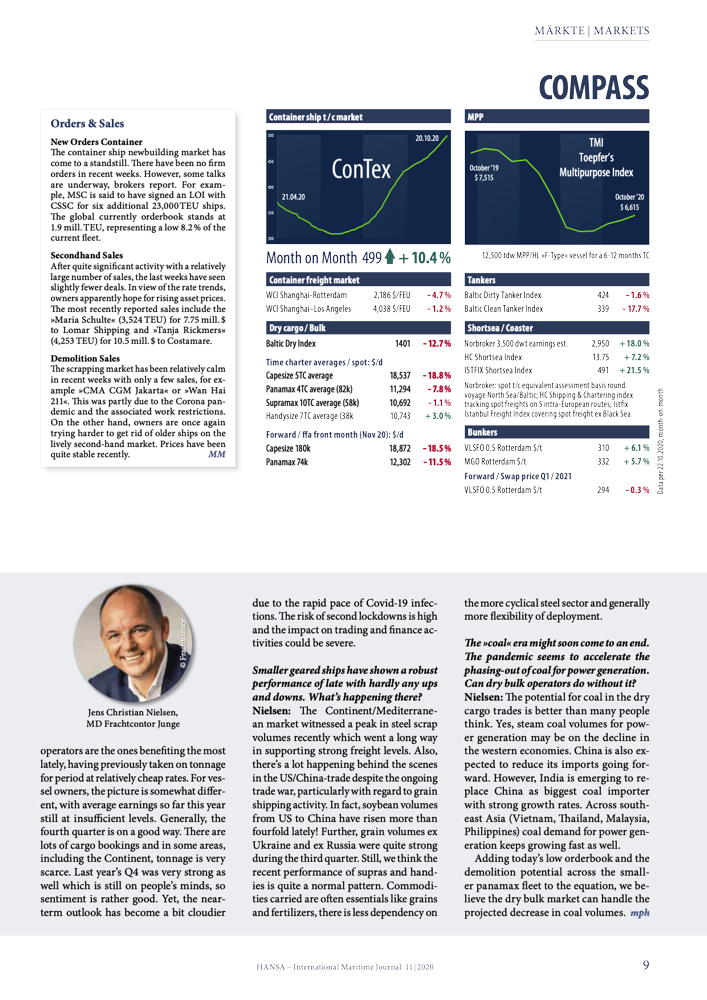The rally in the container markets continues despite the spectre of second lockdowns. A capacity squeeze puts shipowners in the charter market firmly in the driving seat.
Concerns that the recent boom may begin to stutter after the Golden Week have proven unfounded to date. Unlike in[ds_preview] previous years, the week-long national holiday with large-scale plant closures in China seems not to have marked a turning-point, with ships reportedly continuing to sail fully laden from the Far East to consuming centres of North America and Europe.
Just a handful of ships
The ongoing strength in freight rates bears testimony to it, so does the idle fleet count by Alphaliner which dropped to its lowest level in the month of October for five years. As per 12 October, the market research unit recorded 130 idle ships with a total capacity of 438,410TEU (both liner- and tramp-controlled). This was just 1.8% of global capacity, largely made up of tonnage berthed or dry-docked in shipyards or faced with arrest or boycott. Some experts who analysed the statistics more closely suggested that no more than 15,000 TEU were available to be reactivated at short notice – literally just a handful of unfixed tramp vessels. Spot/prompt tonnage two weeks forward is the tightest it has been for a long time with more and more segments even below 3,000 TEU marked as »sold out« for immediate delivery.
Average charter rates continued to increase at breakneck speed by around 10 % throughout the last month, for some classes such as 2,700 TEU gearless, 3,500 TEU gearless and 8,500 TEU post-panamaxes gains were even closer to 15%. Other eye-catching trends included steeper regional rate increases in the Atlantic where the market had been lagging behind Asia due to greater numbers of unemployed vessels.
Fixing levels have been catching up, especially in the panamax sector: While vessels in the Atlantic were previously forced to accept discounts of several thousand dollars versus ships in Asia, the gap has now disappeared. Brokers assess rates more or less at similar levels of minimum 17,000 $/day.
For gearless 2,700 TEU and geared 2,500 TEU ships there was still a gap of 1,000-2,500 $/d between west and east of Suez, albeit gradually diminishing. The spot supply of vessels below 2,000 TEU in North Europe dropped to zero for the first time in many months. By the middle of October, all that was left were five feeder ships in cold lay-up. Operators, pressed for capacity amid surging transhipment volumes from Asia, found no extra vessels.
The few owners taking redelivery of ships and offering them back to the market achieved notable gains. Rates for 1,000 TEU ice class ships firmed up from very low to mid 5,000 €’s, soon to be outstripped by a Damen 800 type reportedly extended at 5,700 €/d for 5-7 months.
Tonnage demand also picked up in the Med allowing rates for 1,100TEU units to move up higher in the 6,000’s $/d while those for geared 1,700TEU and also for 1,300TEU recovered to over 7,000$/day.
More for longer …
Further, there has been quite an increase in periods, with owners succeeding in securing higher rates for extended durations. A case-in-point was the extension of the 8,600 TEU »Hyundai Mercury« at 30,000 $/d for 30-32 months by MSC. Most other fixtures in the segments above 3,000 TEU were done for at least 9 months, taking ships comfortably into next summer. There were also longer period fixtures for sub-panamaxes, with the 2,824 TEU »AS Cardonia« reportedly extending with Zim for 18 months at 11,500 $/d in the Med.
So, how much longer can the rally go on? More and more analysts agree that the recent cargo boom is driven by two transient trends. First of all, consumer behaviour in the western world has shifted from services to consumer goods which have to be packed and shipped. Secondly, businesses across many sectors kicked off a restocking cycle after running down their stocks during the lockdowns.
How long it will take them to get back to »normal« stock levels, is up for debate. The signs are that the process will continue into next year with further peaks to be reached ahead of Christmas and ahead of Chinese New Year. In the US, the business inventories/sales ratio dropped to the lowest in more than five years back in August. At a level of 1.32, the ratio was 5.5% lower than in August 2019 – and that was before the christmas shopping season had even started. Should the current spate of corona infections dampen consumption, inventories-to-sales would of course begin to relax. Tracking the pulse of trade will be more important than ever in the coming months.
Orders & Sales
New Orders Container
The container ship newbuilding market has come to a standstill. There have been no firm orders in recent weeks. However, some talks are underway, brokers report. For example, MSC is said to have signed an LOI with CSSC for six additional 23,000 TEU ships. The global currently orderbook stands at 1.9mill. TEU, representing a low 8.2% of the current fleet.
Secondhand Sales
After quite significant activity with a relatively large number of sales, the last weeks have seen slightly fewer deals. In view of the rate trends, owners apparently hope for rising asset prices. The most recently reported sales include the »Maria Schulte« (3,524TEU) for 7.75mill. $ to Lomar Shipping and »Tanja Rickmers« (4,253TEU) for 10.5mill. $ to Costamare.
Demolition Sales
The scrapping market has been relatively calm in recent weeks with only a few sales, for example »CMA CGM Jakarta« or »Wan Hai 211«. This was partly due to the Corona pandemic and the associated work restrictions. On the other hand, owners are once again trying harder to get rid of older ships on the lively second-hand market. Prices have been quite stable recently.
Michael Hollmann


















